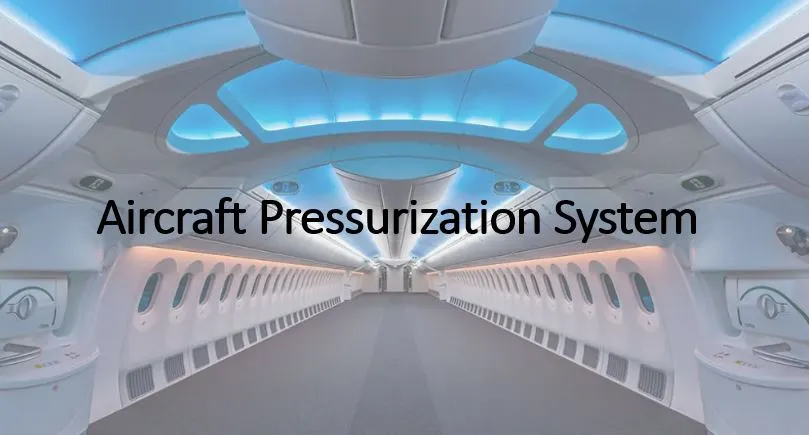Flying at high altitudes comes with unique challenges, including maintaining a breathable environment for passengers and crew. This is where an aircraft pressurization system becomes critical. In this article, we’ll dive into how these systems work, their key components, and why they are essential for safe and comfortable air travel.
What is an Aircraft Pressurization System?
An aircraft pressurization system ensures that the cabin pressure inside the airplane remains at a level where humans can breathe comfortably, even when the aircraft is flying at altitudes of up to 40,000 feet. At such heights, the outside air pressure is too low to support human life. Without pressurization, passengers could experience hypoxia, a condition caused by insufficient oxygen.
How Does the Pressurization System Work?

Aircraft pressurization systems rely on a controlled supply of compressed air, typically sourced from the engines’ bleed air or an auxiliary system. Here’s a step-by-step breakdown:
Compressed Air Supply
Compressed air is typically supplied to the cabin from the engine or other sources, such as a compressed air compressor, through air-conditioning packs. In newer aircraft like the Boeing 787, there is no use of bleed air as a source of compressed air. Instead, the aircraft employs electric compressors, known as Compressed Air Compressors (CAC), to provide pressurized air for cabin pressurization and air-conditioning.
Cooling and Conditioning
As the air is compressed, its temperature increases, requiring cooling and conditioning before it is supplied to the cabin. This is done by the air-conditioning packs. This pressurized and conditioned air ensures a comfortable environment for the passengers.
Maintaining Cabin Pressure
The pressurization system adjusts the air pressure to simulate an altitude of around 6,000–8,000 feet, regardless of the aircraft’s cruising height.
A cabin pressure controller monitors and maintains optimal pressure levels.
Outflow Valve Control
The system uses outflow valves to regulate the amount of air exiting the cabin, maintaining a steady pressure differential. This outflow valve helps to obtain correct aircraft cabin pressure for human body at high altitude.
Key Components of Aircraft Pressurization
- Bleed Air System: Supplies compressed air from engines.
- Air Conditioning Packs: Cool and condition the air.
- Outflow Valves: Regulate cabin pressure by releasing excess air.
- Cabin Pressure Controller: Automates and monitors pressurization.
- Safety Relief Valves: Prevent over-pressurization by releasing excess air if necessary.
Why is Cabin Pressurization Important?
Flying without a properly functioning pressurization system can have serious consequences:
- Passenger Safety: Prevents hypoxia and other altitude-related health risks.
- Structural Integrity: A controlled pressure differential protects the aircraft fuselage from excessive stress.
- Comfort: Provides a breathable environment and reduces fatigue during long flights.
Common Issues with Aircraft Pressurization Systems
Aircraft maintenance teams must regularly inspect and troubleshoot the pressurization system to avoid potential issues such as:
- Cabin Altitude Warnings: Triggered when cabin pressure rises above safe levels.
- Faulty Outflow Valves: Can lead to poor pressure regulation.
- Leaks in the Fuselage: Resulting in loss of pressure.
what happened if an aircraft looses pressurization system at high altitude?

When pressurization fails at 40,000 feet, the rapid loss of cabin pressure poses a serious threat to passengers and crew. Modern aircraft are equipped with several safety features and emergency protocols to mitigate these risks. Here’s a breakdown of these features:
If an aircraft loses its pressurization system at high altitude, the consequences can be severe, but modern aircraft are designed with safety features to handle such emergencies. Here’s what happens step by step and the key actions taken to protect passengers and crew:
1. Immediate Loss of Cabin Pressure
- At cruising altitudes (usually between 30,000 and 40,000 feet), the outside air pressure is very low (around 1/3 of sea-level pressure), and without pressurization, the cabin air pressure drops rapidly.
- Hypoxia (lack of oxygen) sets in almost immediately. Symptoms include dizziness, shortness of breath, confusion, and loss of consciousness if oxygen is not provided within a short time.
2. Oxygen Masks Deploy
- When the pressurization fails, oxygen masks automatically drop from overhead compartments for both passengers and crew.
- These masks provide supplemental oxygen to maintain adequate oxygen levels in the bloodstream until the aircraft descends to a safer altitude.
3. Rapid Descent
- The pilots will initiate a rapid emergency descent to an altitude below 10,000 feet, where the air pressure is sufficient for safe breathing and supplemental oxygen is no longer needed.
- This descent typically happens at a rate of 6,000 to 8,000 feet per minute and lasts for a few minutes, depending on the aircraft’s altitude and the situation.
4. Loss of Cabin Pressure Effects
- In the short term (within seconds to a few minutes), passengers and crew may experience symptoms of hypoxia, such as confusion, dizziness, and loss of consciousness.
- Structural Integrity: Aircraft are built to withstand rapid decompression, but the fuselage and windows must remain intact to prevent further complications.
- Cognitive Impairment: If oxygen is not restored in time, prolonged hypoxia can cause permanent brain damage, organ failure, or even death.
5. Flight Crew Response
- The flight crew, well-trained for such emergencies, will follow established protocols, including putting on their own oxygen masks, communicating with air traffic control, and ensuring the aircraft descends safely and efficiently.
- Crew members also make sure to communicate with passengers, instructing them to remain calm and properly use the oxygen masks.
6. Possible Impact on Passengers
- Unconsciousness: If an individual loses consciousness due to lack of oxygen, they will revive once the oxygen mask is used, provided they are within the window of time for recovery.
- Fatigue or Discomfort: Even with supplemental oxygen, passengers might feel fatigued or uncomfortable due to changes in cabin pressure, especially if the pressurization failure persists for a longer duration.
Conclusion
The aircraft pressurization system is an engineering marvel that ensures passenger safety and comfort while cruising at high altitudes. By maintaining a controlled cabin environment, it allows us to enjoy modern air travel without worrying about the challenges of high-altitude flight.
For aviation enthusiasts, mechanics, and passengers alike, understanding the fundamentals of pressurization offers a glimpse into the sophistication behind every flight.




2 thoughts on “Aircraft Pressurization system: Your safety at high altitude!”
Comments are closed.